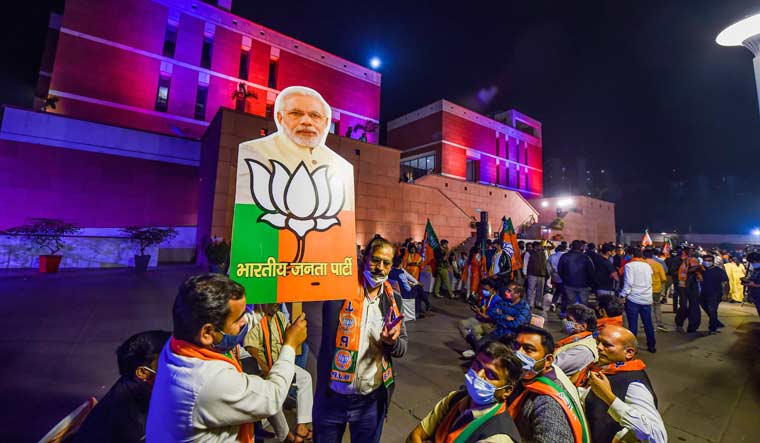In the Bihar cliff-hanger, the NDA claimed victory securing simple majority over the rival RJD-led grand alliance. Prime Minister Narendra Modi thanked the voters for the mandate and pledged to work for the state. Modi thanked the women and the poor of the state for expressing their faith in the alliance.
Before Modi, senior BJP leaders including Home Minister Amit Shah, party chief J.P. Nadda had claimed victory. The party also held a press conference to claim victory, even as the Election Commission was yet to declare the results on all the seats.
Both the BJP and the JD(U) claimed that they have crossed the 122 mark, even as the RJD had claimed that there was some mismanagement in the declaration of the results.
The big takeaway of the elections is putting the BJP in a dominant position in the alliance where Nitish Kumar-led JD(U) has come in a diminished stature. This is the first time that saffron party will be calling the shots in the alliance as it will have majority of ministerial positions in the next government. The BJP gained from Modi's popularity in the state, and the astute strategising it did as the LJP contested separately particularly against the JD(U).
Second biggest takeaway of the elections result has been rise of Tejashwi Yadav. Though, the RJD-led grand alliance came with the striking distance of forming the government, these elections marked the emergence of Tejashwi Yadav as the a strong leader in the state. Even if Nitish Kumar goes on to become the chief minister for fourth consecutive term, he will face a resurgent opposition in the house. The wafer thin majority for the NDA will be a cause of concern for the party. Yadav was the lone face representing the grand alliance, while he had Modi, Nitish Kumar and whole array of senior NDA leaders on the other side.
The third takeaway of Bihar elections is the inability of the Congress to recover its lost glory. The party's strike rate in the elections was around 30 per cent as it could win only 20 seats out of the 70 it contested, as compared to the Left parties who managed to win 18 seats out of the 29 seats they contested. Had the Congress done well, then the grand alliance could have surpassed the NDA grouping in numbers.
The fourth takeaway of the elections is the emergence of the AIMIM in the state politics. Asaduddin Owaisi-led party won five seats thus indicating that Muslims were looking at alternatives to the Congress and the RJD who had traditionally represented their interests in the state. Owaisi will next contest elections in West Bengal and Uttar Pradesh. He is the man the political parties no longer ignore.
The fifth takeaway of the elections is that the state still retains its trust in the social combination to win the elections. As the BJP aligned with the JD(U), the HAM and the VIP, it got votes from all the caste groups. The LJP which contested alone was wiped out, only damaging the JD(U) in the process. Similarly, the grand alliance had RJD which got Yadav and Muslim votes, apart from the votes it polled through the Congress and the Left parties.







